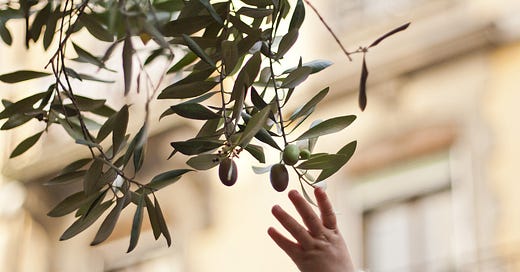Image
Humans are not ruminants. We don’t need to have our noses to the trough every waking moment. But perhaps lunch was inadequate, and dinner a far-off dream. There’s a gnawing sensation in both mind and body. What to do?
When the need arises, that jar of olives that’s been idling at the back of the store cupboard for longer than you can remember offers the ideal solution to those pre-dinner rumblings. You could even call it a starter.
A plump green or wrinkly black olive is the perfect amuse-bouche for pre-dinner loafing, especially when entertaining. Olives also make an ideal emergency snack food, not just because of their suggestion of sophistication but because of their high fat, fibre, and vitamin E content. Furthermore, despite being a fruit, the olive contains virtually no carbohydrate. Perfect for all you low-carb weight-watchers.
The edible, pitted, portion of olives contains around 11g of fat per 100g. That’s mainly monounsaturated fat, the sort that makes olive oil so beneficial to heart health.
But their nutritional goodness doesn’t stop there. What elevates them to class A snack status is their remarkable polyphenol content.
Polyphenols are those protective antioxidant compounds so beloved of your heart and other essential organs. There thousands of different types of polyphenols found within plant foods, and they are all unique. Olives have around thirty different polyphenols, the best researched being oleuropein.
Oleuropein lowers blood pressure. Studies also show that it has “cardioprotective, anti-inflammatory, antioxidant, anti-cancer, anti-angiogenic and neuroprotective functions, and thus may be of therapeutic potential for a variety of human disorders.”
Not bad, for a bitter little fruit.
The processing process
You can’t just pick an olive off a tree and eat it — this fruit is exceptionally bitter and unpalatable, because of its oleuropein content. Therefore, some sort of processing must take place to make the olive edible. Rather too much processing (for my tastes) is carried out on commercially-produced olives. Fortunately, traditionally processed olives are also available.
Traditional processing involves washing and then soaking the olives for several weeks in water. They are then cured in brine. Traditionally cured olives are allowed to ferment, a process which can take several months and one which kills bacteria and causes the bitter compounds to leach out.
Dry curing is another option, often used in Greece. Olives are covered in dry rock salt and left for several weeks. This results in them looking a bit wrinkly because of the dehydrating effect of salt. They may be marinaded in herbs, chilli, garlic or spices for extra flavour. Black olives are green ones that have been allowed to ripen on the tree and lose some of their bitterness.
Unfortunately, your chances of eating traditionally cured or naturally ripened olives are somewhat diminished if you are in the habit of buying olives from supermarkets. The commercial olive-curing business has no truck with time-consuming traditional methods, preferring instead to deploy a speedier, more chemical approach.
Then you had to spoil it all….
Commercial curing commonly involves soaking the olives in caustic soda (lye-curing) to remove the bitterness before they are heat treated. You won’t find caustic soda on the label as it is categorised as a processing aid rather than an ingredient.
Unlike traditionally cured olives, commercially processed olives must be heated to a high temperature to pasteurise and sterilise them, thereby removing all trace of bacteria along with any hope of a full flavour. Indeed, this method leaves a slightly metallic taste on the olives.
As you would expect, olive connoisseurs turn their noses up at caustic-soda soaked, pasteurised olives and seek out traditionally cured varieties, often described as “fresh” olives. These unpasteurised, unsterilised fruits have a much fuller and more natural flavour and are, thankfully, still available to purchase, in specialist shops and on-line.
Nutritionally, there’s no difference between green and black olives. And, of course, there are as many varieties of olive as there are apple: it’s all a matter of taste.
The sweet, mild Italian nocellara is very popular at the moment. A quick on-line search will reveal that this too is available in its naturally ripened and unpasteurised format. So too is a personal favourite, the Greek kalamata.
Whatever olive you settle on for your perfect pre-dinner snack, make sure it is marinated in extra virgin olive oil or brine. Eschew anything floating in refined vegetable oil, such as sunflower oil. Refined vegetable oils are a crime against human health, so heinous that they require a separate article.
So there you have it: olives are the only snack that is sophisticated, healthy, and socially acceptable before dinner. They can be an acquired taste, but one worth pursuing.
This article first appeared on Medium in October 2021





The big question is, where in the world would you find traditional olives? Not in rural Canada, that I know of. I will have to make do with store-bought.
Thank you for posting some of your content that I missed before finding you on Medium. Much appreciated!